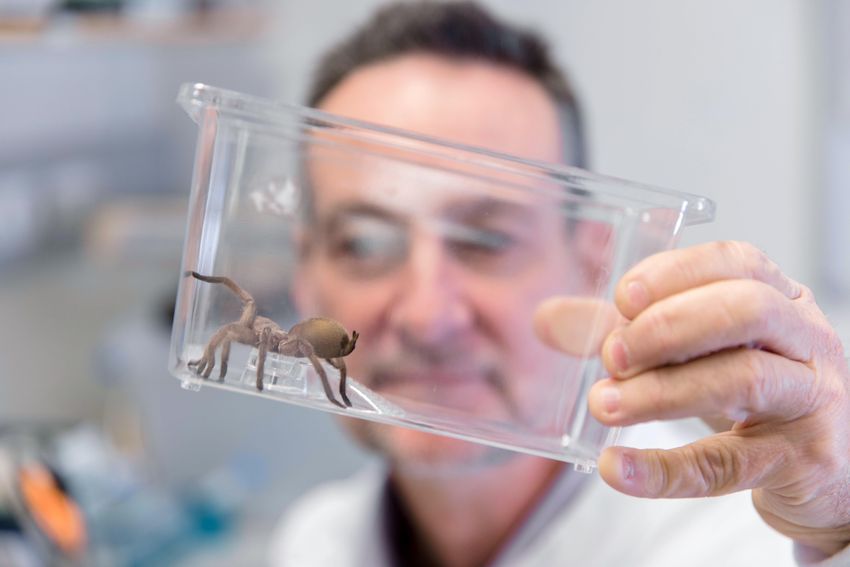The venom of the K’gari funnel web spider contains a peptide that can prevent a lack of oxygen from killing cells.
Image credit:Bastian Rast; The University of Queensland's Institute for Molecular Bioscience
Spiders can take down a wide range of prey items through their pharmacologically complex venoms; conservative predictions place the total number of bioactive peptides in spider venoms at more than 10 million.1 While a handful of these venoms are deadly to humans, most are not, and many can be incredibly useful.
Glenn King, a biochemist at the University of Queensland’s Institute of Molecular Bioscience, who studies spider venom, has discovered chemical compounds that can be used to treat stroke, cardiovascular disease, epilepsy, pain, and many more diseases over the years. His work recently also led to a therapy that could save heart attack and transplant patients.
Before his success in human therapeutics, King’s interest in spider venom was motivated by bugs. Around 20 years ago, King investigated spider venoms to identify compounds that would kill pest insects with high specificity and leave beneficial pollinators unaffected. After successfully developing such bioinsecticides and founding a spinoff company, King shifted his focus. “I began to realize that these venoms were extremely complex, and most of the compounds in them targeted a class of receptors called ion channels,” King said.
Ion channels are the second most common target of all currently available drugs, and they play a role in a range of diseases—primarily nervous system disorders. “Many ion channels are very hard to target with small molecules. They're very complex, and they don't have a lot of real estate outside of the cell membrane, so they're really hard to target with antibodies,” King said.
King decided that they should use the gold mine of spider venom peptides that target these receptors to develop human therapeutics. He and his team didn’t have to look far. About 240 kilometers (approximately 150 miles) north of King’s ‘Bugs and Drugs’ laboratory in Brisbane lies K’gari, the world’s largest sand island. The island is home to a funnel-web spider that has been isolated from mainland funnel webs for millennia. Known to local indigenous Australians as ‘mudjar nhiling guran’, or the long-toothed spider, it uses its formidable fangs to deliver one of the most complex and lethal spider venoms in the world. In addition to its complex venom, they chose this species for pragmatic reasons—its sand burrows are much easier to dig up than those of its mainland relative.
One of the peptides in the K’gari funnel web spider’s venom stood out in initial screens against relevant ion channels. “We found this amazing molecule called Hi1a and looked at it in a [mouse] model of ischemic stroke, which is by far the largest proportion of strokes,” King said. “We found that when we delivered it two or four hours after a stroke, we could reduce the brain damage by 80 percent.”

Biochemist Glenn King studies the millions of peptides in spider venom to develop novel therapies for nervous system and cardiovascular disorders.
Anjanette Webb; The University of Queensland's Institute for Molecular Bioscience
In an ischemic stroke, the oxygen supply to cells and tissues of the brain is cut off, which results in a more acidic pH within the affected tissues. This lower pH activates the acid-sensing ion channel 1a (ASIC1a), which in turn causes cell death and permanent tissue damage. By blocking ASIC1a, the Hi1a prevents brain damage progression following an ischemic stroke—even up to eight hours after the event.
King and his team wondered if it could be effective in other organs that are susceptible to ischemic injury. Over coffee with his new colleague Nathan Palpant, a cardiac physiologist who studies cardiac ischemia, King questioned whether the same ion channel Hi1a targets in the brain was also present in heart tissue.
Palpant wasn’t sure at the time, but this piqued his interest. “We started collaborating virtually immediately,” King recalled. After some initial research, they found that not only was ASIC1A expressed in human hearts, but there was a strong correlation between heart attacks and the mutations in the gene that codes for the ion channel. “We went on to show that we could reduce the injury after a heart attack using [Hi1a] as well,” said King.
It wasn’t long before other potential collaborators got wind of what they were up to. One of those collaborators was Peter Macdonald, a cardiologist and heart transplant pioneer at the Victor Chang Cardiac Research Institute. As soon as hearts are removed from donors, they begin to sustain ischemic injury, so Macdonald wanted to explore the use of Hi1a in keeping donor hearts viable for longer. “[Macdonald] showed that for rodent and pig heart transplantations this molecule does an amazing job,” King remarked. “In fact, the most profound effects are probably in the context of heart transplantation.”
The team is also using Hi1a and other spider venom peptides to treat a variety of other conditions. Working with tarantula venom and brain organoid models, King and his collaborators at The Florey Institute are developing therapies for inherited forms of epilepsy caused by mutations in voltage-gated ion channels. Tarantula venom has also yielded a novel inhibitor of a voltage-gated sodium channel that causes chronic visceral pain associated with irritable bowel syndrome and endometriosis.2
According to King, this type of research wouldn’t be possible without recent advances in omics technologies, which have allowed scientists to interrogate complex venoms and identify their useful fractions. Since only a small portion of the millions of spider venom peptides have been studied to date, there could be many more life-changing therapies just around the corner. “There are currently six [approved] venom-based drugs, and some of them have been incredibly impactful,” he emphasized.
King said that a miniaturized ‘mimic’ of Hi1a has now been approved for Phase I clinical trials in heart attack and heart transplant: “We're only three or four months away from [beginning human trials], which is exciting, and terrifying at the same time.”
.png)



